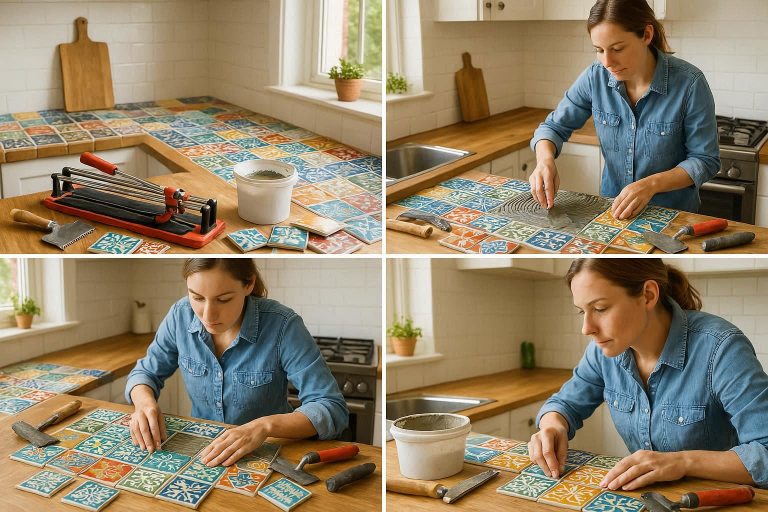Choosing the right material for your kitchen countertop is essential for both functionality and aesthetic appeal. Whether you’re upgrading your existing space or creating a brand-new look, the material you choose will play a significant role in your kitchen’s overall design. Among the many options, tile remains a popular choice due to its versatility, durability, and customization potential.
If you’re on a budget or want a more personalized design, tiling your kitchen countertop is an affordable and customizable solution. Tiling allows you to create a unique design with a variety of patterns, colors, and textures while also providing a durable, easy-to-clean surface.
In this comprehensive guide, we’ll walk you through everything you need to know about tiling a kitchen countertop, from preparation to installation. Whether you’re wondering how to tile over plywood or laminate, or curious about groutless tile options, this guide covers it all.
Preparing for Your Tile Installation Project
Before diving into the actual installation, it’s important to prepare properly. Selecting the right tile and preparing the surface will make the Healthy Cooking Gadgets Every Home Should Have
whole process go smoother and help ensure a long-lasting result.
Choosing the Right Tile for Your Kitchen Countertop
There are several types of tiles that work well for kitchen countertops. Each material has its own benefits, so it’s important to consider factors like durability, ease of maintenance, and design when choosing the right one for you.
- Ceramic Tiles: These are an affordable and versatile option. They come in various colors, patterns, and finishes, making it easy to match your kitchen’s design.
- Porcelain Tiles: Porcelain is more durable and water-resistant than ceramic, making it ideal for high-traffic areas like kitchen countertops. It’s also less likely to chip or stain.
- Natural Stone Tiles: Materials like granite, marble, and slate offer a more luxurious appearance. While more expensive, these tiles add elegance and are highly durable. However, they require regular sealing to maintain their appearance and prevent staining.
When selecting tiles, think about the overall design of your kitchen. If you have a modern or minimalist aesthetic, neutral-colored tiles may be the best choice. For a more eclectic or traditional look, bright and patterned tiles could add a unique touch.
How to Tile a Countertop Over Plywood
Tiling over plywood is a popular option for those installing tile on a wooden countertop. However, it’s essential to ensure the plywood surface is properly prepared to support the weight of the tiles.
- Step 1: Clean the Surface: Begin by cleaning the plywood thoroughly to remove any dirt, dust, or grease. A clean surface helps the adhesive bond better.
- Step 2: Apply a Backer Board: If you’re tiling over plywood, it’s best to use a cement board or other backer board to ensure the surface is sturdy and waterproof.
- Step 3: Smooth the Surface: Make sure the plywood is smooth and level. Sand any rough spots and fill in any gaps with wood filler if necessary.
- Step 4: Apply Adhesive: Spread a layer of thin-set adhesive over the plywood using a notched trowel. Then, begin laying your tiles.
How to Tile a Countertop Over Laminate
Tiling over laminate is also possible, but it requires more preparation to ensure proper adhesion. Laminate countertops are smooth and may not allow tiles to stick properly without proper surface preparation.
- Step 1: Clean and Roughen the Surface: Start by cleaning the laminate surface with a degreaser to remove any oils or waxes. Then, lightly sand the laminate to create texture, which helps the adhesive bond.
- Step 2: Apply a Bonding Primer: Use a bonding primer to further enhance adhesion between the laminate and the tile adhesive.
- Step 3: Apply Adhesive and Tile: Once the primer is dry, spread the adhesive and begin placing your tiles as usual.
Step-by-Step Guide on How to Tile a Kitchen Countertop
Now that you’ve prepared your surface, it’s time to dive into the actual tiling process. Here’s a detailed, step-by-step guide to help you through each phase of the installation.
Step 1: Gather Necessary Tools and Materials
Before starting, ensure you have all the necessary tools and materials:
- Tile Adhesive: Thin-set adhesive is commonly used for countertops.
- Grout: Choose grout that complements the color of your tiles. Make sure it’s waterproof and stain-resistant.
- Trowel: Use a notched trowel to apply adhesive evenly.
- Tile Cutter: A tile cutter or wet saw is essential for cutting tiles to fit edges and corners.
- Tile Spacers: These ensure that your tiles are evenly spaced.
- Sealant: After installing and grouting, you’ll need a sealant to protect the tiles and grout.
Step 2: Measure and Plan Your Layout
It’s essential to plan your tile layout to avoid wasting tiles and to ensure a professional finish. Measure your countertop area carefully and decide on the pattern you want. Whether you prefer a traditional grid pattern or something more creative like a herringbone design, planning is key to a smooth installation process.
Start from the center of the countertop and work your way outwards. This will help you create a symmetrical design and avoid small, awkwardly cut tiles at the edges.
Step 3: Prepare the Countertop Surface
Make sure your surface is clean, dry, and level before applying adhesive. If you’re tiling over plywood, make sure the backer board is securely in place. If you’re tiling over laminate, follow the preparation steps outlined earlier.
Step 4: Applying Tile Adhesive
Using your trowel, spread a thin, even layer of adhesive over a small section of the countertop. Work in small sections to prevent the adhesive from drying out before you can place your tiles.
After applying the adhesive, press your tiles firmly into place. Be sure to leave a small gap between the tiles for grout. Tile spacers are a great way to ensure even spacing.
Step 5: Cutting Tiles to Fit
When you reach the edges of your countertop, you’ll likely need to cut some tiles to fit. A tile cutter or wet saw is the best tool for making clean, precise cuts. Measure carefully, and don’t forget to wear safety goggles to protect your eyes from tile shards.
Step 6: Grouting the Tiles
Once all the tiles are in place and the adhesive has dried (typically 24 hours), it’s time to grout. Spread grout over the tiles with a rubber float, working it into the gaps between the tiles. Be sure to wipe away excess grout with a damp sponge as you go.
After the grout has set for a few hours, use a clean, dry cloth to buff away any grout haze from the tile surfaces.
Step 7: Sealing and Finishing Touches
Once the grout has fully cured (usually 72 hours), apply a grout sealer to protect it from stains and moisture. This is especially important in high-moisture areas like the kitchen.
Finally, inspect your countertop for any imperfections, making sure all tiles are level and all grout lines are clean.
Additional Considerations for Tile Countertop Installation
Tile Countertop Ideas
Tile countertops can transform your kitchen. Here are a few tile ideas to consider:
- Subway Tiles: These timeless tiles are simple, elegant, and perfect for a clean, modern kitchen.
- Mosaic Tiles: For a more artistic look, consider using mosaic tiles to create intricate patterns or designs.
- Bold Colors or Patterns: If you want to make a statement, try using colorful tiles or geometric patterns that match your kitchen’s style.
Using Floor Tile for Kitchen Countertops
While most people choose specific countertop tiles, you can also use floor tiles for your kitchen countertops. They’re typically thicker and more durable, but they may require extra care when it comes to cutting and handling.
DIY Porcelain Tile Countertop
Porcelain tiles are a fantastic choice for DIYers due to their durability and ease of maintenance. Follow the same steps outlined in the guide above, but keep in mind that porcelain can be harder to cut than ceramic tiles, so you may need specialized tools.
Groutless Tile Countertops
Groutless tile countertops are becoming increasingly popular. These countertops use large-format tiles with minimal grout lines, giving them a sleek, modern look. Installation can be tricky, as the tiles must be perfectly level and well-supported, but the result is a seamless, easy-to-clean surface.
Tiling a Bathroom Countertop vs. a Kitchen Countertop
Tiling a bathroom countertop is similar to tiling a kitchen countertop, but there are some important differences:
- Materials: Bathroom countertops typically require moisture-resistant materials like porcelain or stone. Kitchens often see heavier use, so tiles that resist stains and wear are preferred.
- Design: Bathroom countertops may lean more toward simple, understated designs, while kitchen countertops offer more opportunities for creative expression.
Tile Countertop Installation Repair and Maintenance
Common Tile Countertop Problems
Like any surface, tile countertops can experience problems. Cracked tiles, grout discoloration, and chips are all possibilities. The good news is, you don’t have to replace the entire countertop. Simply replace the damaged tile or re-grout the affected area.
How to Maintain and Clean Tile Countertops
To keep your tile countertop looking great, clean it regularly with a mild cleaner. Avoid abrasive cleaners that can damage the grout or tiles. Use a grout sealer to prevent stains and water damage.
When to Consider Replacing Tiles
If your tiles are cracked, chipped, or stained beyond repair, it might be time to consider replacing them. Replacing individual tiles is relatively easy compared to redoing the entire countertop.
FAQ
Can I tile a countertop over plywood?
Yes! Be sure to apply a backer board and make sure the plywood is smooth before tiling.
Is it possible to tile a countertop over laminate?
Yes, with proper surface preparation like sanding and priming, laminate can be tiled over.
What type of tile is best for a kitchen countertop?
Porcelain and ceramic are the most popular choices due to their durability and water resistance.
Can I use floor tiles for kitchen countertops?
Yes, floor tiles are more durable but can be harder to cut and handle.
What is a groutless tile countertop and how does it work?
Groutless countertops use large tiles with minimal grout lines for a seamless, modern look.
How long does it take to install a tile countertop?
A full installation can take 2-3 days, including drying and curing time for adhesive and grout.
Conclusion
Tiling your kitchen countertop is a rewarding project that can be both budget-friendly and stylish. Whether you’re choosing classic ceramic, durable porcelain, or luxurious natural stone tiles, the result can significantly elevate your kitchen’s look and feel. By following the steps outlined in this guide, you’ll be well on your way to achieving a beautiful and functional countertop that will last for years to come. Ready to start your DIY tiling project? Gather your tools, plan your design, and transform your kitchen today!

